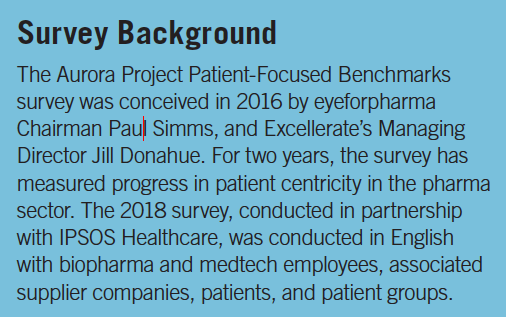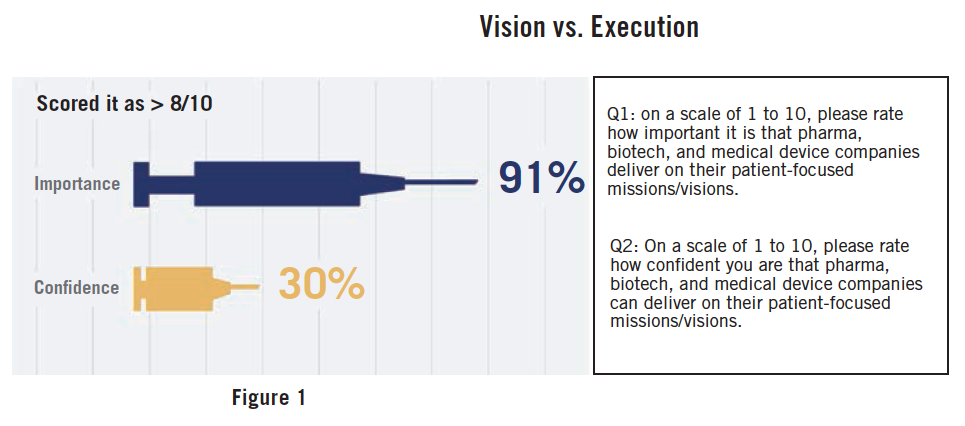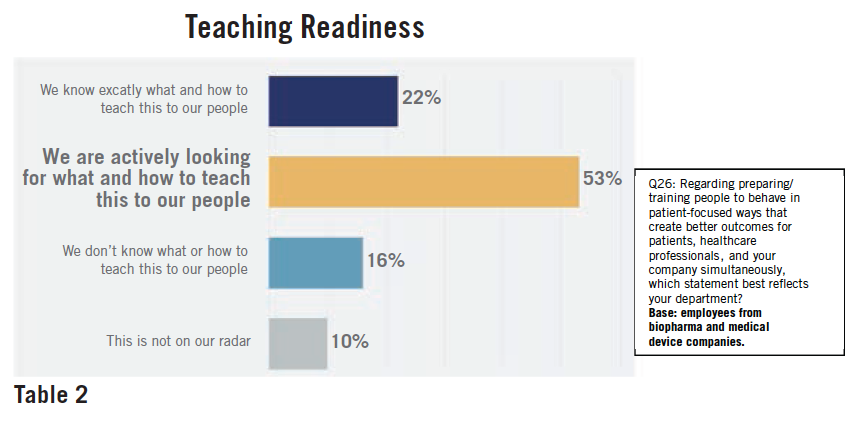The Path to Patient-Focused Accountability
Pharmaceutical Executive
Benchmark survey assesses the industry’s progress so far in moving from words to action in its approach to patient centricity.
Lessons from the 2018 Aurora Project Patient-Centric Benchmark Survey highlight the industry’s progress in moving from words to action in its approach to patient centricity
“They keep telling us we need to be patient centric, but I already am!”
Is this a familiar refrain from your biopharmaceutical colleagues when you talk about patient centricity?
For over a decade, pharma has been talking about the central role of patients as their raison d’etre. Almost without exception, biopharma websites have some version of the line, “Improving patients’ lives are why we go to work each morning.” And so it should be. But how are we actually doing at delivering on those well-intended words to put patients at the center of everything we do?
Survey details; click to enlarge

As illustrated in survey results ahead, significant strides have been made, but there is also much room to improve. To move from words to actions, we need to understand in a more nuanced way how we’re doing. The following are the top six lessons from the 2018 Aurora Project Patient-Centric Benchmark Survey.
1. Importance and confidence on the rise
We asked how important it was that biopharma, biotech, and medical device companies delivered on their patient-focused missions as a way to understand how ready respondents were to deliver on the promise of patient centricity. Ninety-one percent of respondents ranked importance an 8 or more out of 10-a 6% absolute increase from the 2017 survey (see Figure 1 below). We also asked how confident they were that they could deliver on those mission/visions. Although only three in 10 (30%) of the respondents ranked their confidence as 8/10 or more, that was up significantly from the previous year, where only 21% were as confident.

The key insight from the 2018 survey is-once again-the significant gap between how important patient centricity is for respondents versus how confident they are that they can deliver on their patient-centric visions. As will be discussed later in this article, our research suggests this is related to a lack of knowledge of how to be patient centered, and uncertainty over whether we have the will to be it.
Why this is important? Assessing importance/confidence can help determine readiness to change. In order to make meaningful change related to a given behavior, people need to feel like the behavior is worth changing (importance) and that they believe they can change it (confidence). As Gareth Phillips, managing director, UK, and head of EMEA at Ipsos Healthcare, notes: “It’s clear that biopharma wants and needs to be patient centric. While there was some improvement over the 2017 survey, respondents in the 2018 survey remain much less confident on how best to do that.”
2. How biopharma sees itself, how patients see biopharma
In order to understand how well the biopharma industry is serving patients, the Aurora Project Survey planning committee felt it was important to understand clearly what patients want. Guy Yeoman et al. addressed this well in their 2017 BMJ article entitled “Defining patient centricity with patients for patients and caregivers: a collaborative endeavor.” Through a set of interviews and workshops with patients, the authors identified 10 principles that patients and caregivers expected of biopharma companies. These were then validated by over 1,000 patients.
In the 2018 Aurora Project Survey, we asked biopharma associates and patients the degree to which pharma is patient centered using these 10 principles (see Table 1 below). Across those 10 metrics, patients consistently ranked biopharma companies lower than biopharma associates ranked themselves. On average, 57.5% of biopharma associates ranked their own companies a 4 or above on a 5-point scale where 5 was “strongly agree that they achieved each of the 10 standards.” By comparison, only 42% of patients ranked biopharma companies a 4 or above on the same metric.

Why this is important? Cognitive biases like the ones observed above are commonplace. People often rank themselves more positively than an objective observer would. As Dr. Lode Dewulf, chief patient officer, Servier group, and 2018 Aurora Survey co-lead, notes, “Classical cognitive biases are likely to drive the perception gap in the survey. Biopharma professionals may rate themselves more on intent; patients generally rate those companies on their actions-on what the patients actually see and experience.”
Despite the pervasiveness of these cognitive biases, highlighting them in this detailed way is instructive. Once we are aware of how we’re actually doing at serving patients’ needs through their eyes, we’ll understand more specifically what we need to do to close the gap.
Closing the gap requires an ideological leap for biopharma. Dewulf makes this observation: “There is a difference between working for patients and working with patients. Intent is reflected in for, while with reflects action and method. Historically, pharma has always been working for patients with the best intent, similar to the HCP (healthcare professional). At the same time, patients were-and often still are-excluded from the table; decisions were made for them, without them. Patients want to have a say, they want with.”
There are two metrics in Table 1 where the gap is most pronounced:
- “Communicates with care and compassion, transparent and unbiased information on diseases, treatment options, and available resources.” (29% difference between biopharma and patients)
- “Listens and responds to patient feedback with respect and humility.” (26% difference between biopharma and patients)
Both of these metrics are characterized by qualities that are hard for companies to possess. These are human qualities-the skills and attitudes that must be delivered by company employees. Those people are distributed throughout many departments across the value chain from research to medical and commercial. A frequent focus in biopharma is on value-added patient programs-which makes sense, but those alone won’t help humanize companies. Perhaps we should be asking ourselves, “What are we doing in biopharma to prepare our people to have the attitudes, empathy, and skills to meet these patient needs?”
3. Patient centricity drives engagement and pride
Seventy-six percent of biopharma associates are confident that their company is making the world a better place (see Figure 2 below). Eighty-one percent of associates are proud to tell people outside the industry that they work in a pharma, biotech, or medical device company. Sixty-nine percent agree that “my customers would say that I help improve patient care.”

Why this is important? Historically, biopharma has engaged in patient-centric activities primarily as a means of delivering on its commitment to improve patient outcomes. However, the real win for all may be in its power to engage people within organizations. There is significant research that demonstrates that employee engagement has tangible value to companies and to the employees themselves.
Dan Pink, in his best-selling book, Drive, summarizes 50 years of research on what motivates us in the workplace. He identifies purpose as one of three keys to exceptional performance. The other two being autonomy and mastery.
Jim Stengel, in his book, Grow, shares results from his 10-year retrospective study of the growth of the S&P 500 companies. He teased out the top 50 companies whose growth was significantly greater than all the rest. Stengel’s research into why they did so much better is summarized with one word: purpose. The top companies had figured out how to focus on their purpose-the difference they make in the world.
Shawn Achor et al., in a 2018 Harvard Business Review article, presented research that demonstrated how meaningful work pays off for both employees and their companies. In the authors’ study of more than 2,000 US employees, they found that, “On average, American workers said they’d be willing to forego 23% of their entire future lifetime earnings in order to have a job that was always meaningful.” From an organizational perspective, they estimated that “highly meaningful work will generate an additional $9,078 per worker, per year.”
4. Patient centricity drives trust in biopharma
In the survey, only 36% of patients say they have quite a bit or a lot of trust in biopharma. To explore biopharma respondents’ self-perceptions of trust, we asked what would happen to trust if a patient could secretly observe their company’s day-to-day activities. Sixty-seven percent of industry respondents agree that patients’ trust would be positively affected if patients secretly observed a typical day in a pharma company.
Why this is important? According to the 2018 Edelman Trust Barometer (ETB), trust in all institutions (governments, corporations, the media, and non-profit organizations) is at an all-time low. For biopharma, another telling finding from the ETB is that 82% of respondents believe that the industry needs more regulation. Moreover, lack of trust has tangible business impact, as it impedes our ability to work collaboratively with patients, healthcare providers, and governments.
Survey findings highlight a growing disconnect between how we feel about our own trustworthiness versus how patients perceive us. In essence, if a company doesn’t think it has a problem at a personal level, it’s less likely to allocate energy or corporate resources to make it better. Layered into this is a lack of training to address deeper cultural aspects of improving trust-beyond compliance initiatives-to ensure laws, rules, and regulations are respected.
Ultimately, closing the gap requires companies to make trust-building a daily habit for employees. Having a patient-centered mindset, where behavior is guided by the question, “Is this good for patients?” is what’s needed. Having patients as our focus connects us with the common mission of healthcare providers and institutions-and makes true partnership possible. It puts us on the same team.
5. Patient-centric strategies and business success
Seventy-three percent of patients and 85% of biopharma associates agree that focusing on patient need leads to better business outcomes. Ninety percent of all survey respondents agree that long-term focus is a key to success with patient-centric efforts. This need is sometimes at odds with business realities, with 53% of biopharma associates saying their companies are mostly concerned about results.
Why this is important? The idea that companies can’t meet both their financial needs and the needs of society is rapidly fading. The research on purpose-driven people and organizations provides plenty of evidence that being driven by purpose is key to exceptional performance.
“Much like technology a few decades ago, purpose has now become a business imperative,” says Aaron Hurst in The Purpose Economy.
Creating a purpose-based culture and earning the trust of patients and partners requires a longer-term focus than our business horizons usually permit. As Bjorn Gustaffson, global head of customer-facing excellence at UCB, notes: “Creating a purpose-based culture, and earning the trust of patients and partners, requires a constant and long-term focus.”
Another demonstration of the value of a patient-centric approach is in clinical trials. “The Innovation Imperative,” a report by the Economist Intelligence Unit, found that “…drugs developed using patient-centric designs were more likely to be launched compared to drugs developed without, with nearly 20 percentage point difference (87%) when compared to the control group (68%).” They also found that patient-focused trials took less time to recruit patients. Similarly, Levitan et al. made the case, in an economic analysis published in Therapeutic Innovation & Regulatory Science, that patient engagement in pre-Phase II and III trials could result in, “… gains in NPV (net present value) and ENPV (expected net present value) [that] can be several hundred times the investment for engagements that avoid an amendment and improve the patient experience.”
6. Training is the missing ingredient to execution
As shown in Table 2 (see below), 53% of biopharma associates responded in the survey: “We are actively looking for what and how to teach patient centricity to our people.” Only 22% said: “We know exactly what and how to teach patient centricity to our people.” Another 16% say: “We don’t know what or how to teach patient centricity to our people.” When you combine the “actively looking” group with the “we don’t know what or how to teach group,” we see that 69% are trying to figure out how they should train people to be patient centric.

Why this is important? When the finding that 30% ranked their confidence as 8/10 or more is juxtaposed with the finding that 69% of people don’t know what or how to teach patient centricity, one of the key insights from the survey emerges.
The low confidence is, in large part, a function of not knowing how to be patient-focused. This brings us back to the million-dollar question: How do we make patient centricity more than just words? It starts with, what does patient centricity mean to the pharma executive? While some think patient centricity belongs to a particular department in the organization, we believe that it needs to live in the culture of companies.
The foundation of being patient-focused is being purpose-driven. “Building a deep and authentic sense of purpose could be a company’s ultimate competitive advantage,” says Rick Wartzman, author of The End of Loyalty.
It’s time to take the vision off the wall and embed it in the hearts and hands of every single person in an organization. Gamze Yuceland, GM of Takeda Canada, agrees. “Instead of defining how our people should be patient-focused, we are empowering each of them to connect with their own purpose and define for themselves what being patient centric means to them,” she says. Yuceland believes employees will develop more and better ideas of how to be patient centric than the company could ever direct them to. And, further, they will be more motivated to act on those ideas.
In Alive at Work, acclaimed social psychologist Daniel Cable outlines the two key ingredients that help people become purpose-driven.
- Help people see the difference they are making.
- Help them develop their own story about the “why” of their work.
Some life science companies have had success with the first point. Whether it’s sharing patient stories, pictures on the walls, immersive opportunities, volunteer work with patient organizations, or virtual patient simulations, companies are starting to help their employees empathize with the patient. An increase in quantity and consistency of this exposure is definitely needed. As Doug Noland, head of patient experience at Astellas, says, “helping our people empathize with the patient experience has been a key focus for us and we see a difference.”
For many, the second purpose-driven ingredient remains elusive, particularly how one’s individual purpose connects to their organization’s purpose. Donahue runs a workshop called “The Power of Purpose” to help individuals make this connection. “People are transformed when they connect to their purpose: the patient,” says Donahue, “both in how they see themselves and how others see them. They become more committed, more passionate, more innovative, more engaged and engaging.”
Moving to patient-focused accountability benchmarks
The Aurora Project Patient-Centric Benchmarks Survey has been a great tool in helping pharma measure progress in patient centricity. The main limitation of the Aurora Project surveys to date has been selection bias: the possibility that those most interested in patient centricity might be more likely to complete the survey. In order to help the biopharma industry move from words to actions to outcomes, we need more robust and accountable data to know how we’re doing.
We believe that patient-centric accountability (PCA) is the next phase in the evolution of the patient-centricity movement in biopharma. PCA is the idea that biopharma companies deeply benchmark how they are doing at an organizational level with all associates-not just those with an interest in patient centricity. Those benchmarks would allow companies to cascade responsibility for patient-centric outcomes within their organizations that could be included, as an equal measure, with financial performance.
Just the beginning
While many in pharma feel we’ve already “checked the box” on patient centricity, the 2018 survey shows that we’re only at the beginning of the journey of moving beyond words. Patients can’t wait for us to put them authentically at the center of our value-creation models. They need companies to continue innovating-not just with medicines but with patient-focused business processes and people.

John Elliott is Managing Director, Excellerate, and Project Lead of The Aurora Project. He can be reached at john.elliott@excellerate.ca. If you or your company are interested in being part of the next survey, please reach out to Mr. Elliott.

Addressing Disparities in Psoriasis Trials: Takeda's Strategies for Inclusivity in Clinical Research
April 14th 2025LaShell Robinson, Head of Global Feasibility and Trial Equity at Takeda, speaks about the company's strategies to engage patients in underrepresented populations in its phase III psoriasis trials.